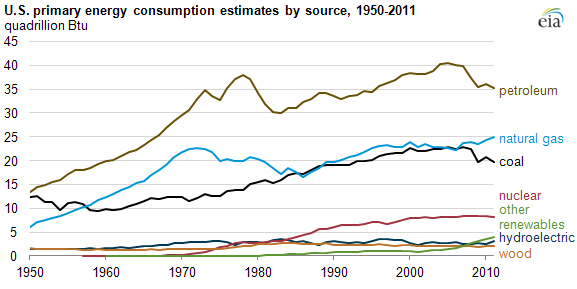
Energy Perspectives: Fossil fuels dominate U.S. energy consumption

While the United States produced a record 78 quadrillion Btu (quads) of energy in 2011, it consumed more than 97 quads of energy in various forms. Nonrenewable fossil fuels made up more than four-fifths of U.S. energy consumption.
As has been the case since 1950, petroleum was the most-consumed fuel in 2011, at 35.3 quads. Use of petroleum, which includes crude oil as well as natural gas plant liquids, has fallen recently from its peak historical level of 40.4 quads in 2005. Natural gas, which had been consumed in roughly equal amounts to coal for several years, accounts for almost 25 quads compared to coal's 20 quads in 2011. Natural gas and renewable energy were the only fuel sources whose consumption increased in 2011.
Renewable energy consumption surpassed nuclear in 2011, with 9.1 quads compared to nuclear's 8.3 quads. Renewable energy includes 4.4 quads of biomass energy—wood, wood waste, and the biomass portions of fuel ethanol and biodiesel—as well as 4.7 quads of noncombustible renewable energy, which includes conventional hydroelectric power, geothermal, solar thermal, photovoltaic, and wind. Not shown above are net imports of electricity, which contributed only 0.1 quad to 2011 consumption values.
Time series for several energy production characteristics, along with details about data collection and conversion, are available in EIA's Annual Energy Review.